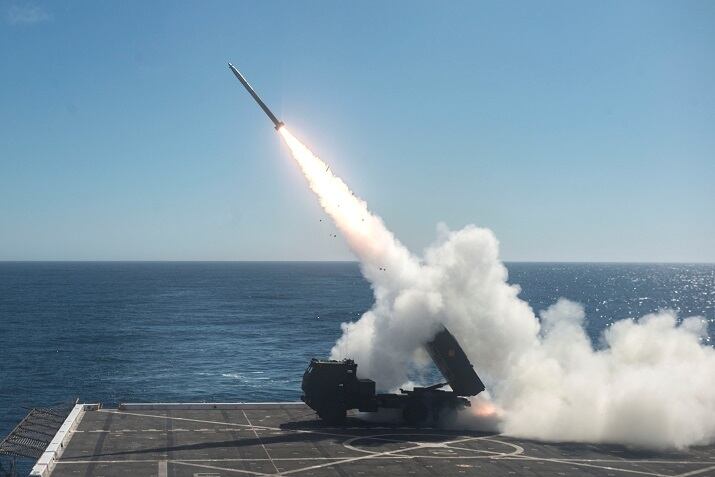The Marines Corps is looking to counter a threat not faced since World War II ― enemy navies capable of firing at Marines ashore.
Marines need a mobile anti-ship, coastal defense system that can fire at moving, sea-based targets and also pack up and move before being detected. Oh, and it needs to fit on a C-130 aircraft.
Now the Corps is asking the defense industry for just such a missile system, capable of a range of 80 miles or more.
“A complete coastal defense system would be composed of a command and control center, and a surveillance and Over the Horizon (OTH) target acquisition capability, in addition to the kinetic launch system,” according to the formal Request For Information recently issued by Marine Corps Systems Command.
The missile may attract the most attention. But for planners, the most important aspect is how that missile will integrate into the larger sea control mission that the Marines, Navy and in many ways the Army is developing.
The RFI is an effort to see what the defense industry might have to offer now or soon as the various missile projects proceed, said Kevin McConnell, deputy director of fires and maneuver for the Corps’ combat development and integration team.
Being the smallest military service with the lowest budget, the Marines are dependent on the Army’s current effort to improve and extend its high-mobility rocket system, known as HIMARS.
HIMARS is a vehicle-mounted light rocket launcher already in use by both the Army and Marines. It fits on a C-130 and fires artillery rockets, either a single Army Tactical Missile System or six Guided Multiple Launch Rocket System.
The Army’s HIMARS improvements, including some of those to make it anti-ship capable, are between five and seven years away, McConnell said.
Nearly a year ago, Marine Commandant Gen. Robert B. Neller said he wanted an anti-ship, coastal defense missile in the Marine’s arsenal. And he wanted to use existing platforms such as HIMARS.
Benefits of using the existing platform are lower costs and the already available trained soldiers and Marines who can fire them.
Firing from land at a moving ship with air defense systems would require a guided missile capable of redirecting its flight, not simply striking a preprogrammed grid location. The missile would also need warheads capable of coming in horizontally near the water’s surface amid waves and then puncturing the ship’s hulls.
But Marines can’t just fire at will into the ocean. Their targeting must coordinate with friendly ships and aircraft in the same battle space. That requires integrating the fire system into the Navy’s broader network for command and control at sea.
McConnell said Marines are monitoring developments both from the Army’s HIMARS program and from missiles traditionally fired from Navy ship platforms to the coast, namely the Harpoon and Naval Strike Missile.
Both have been or will soon be demonstrated capable of being mounted on a land platformed and fired, he said.
But costs are prohibitive.
McConnell told Breaking Defense that the GMLRS missiles both Marines and Army use run $100,000 to $200,000 each while the ATACMS run $750,000 to $820,000 apiece.
The entry-level Harpoon or Naval Strike Missile price tag starts at $1 million, McConnell said.
Marines have been finding novel ways to use HIMARS from the other direction, ship to shore.
On Oct. 24, the Marine Corps successfully fired a HIMARS from the flight deck of the amphibious transport dock Anchorage, destroying a target the size of a speaker’s podium on land 70 kilometers away.
RELATED

The test came shortly after Neller said that amphibious ships would be equipped with precision fires to make sure they could destroy enemy coastal defenses.
Having a HIMARS aboard an amphibious ship gives commanders a weapon that can attack targets ashore when weather is too bad for aircraft to fly, said Lt. Col. Matt Hawkins, the fires and effects coordinator with the 1st Marine Expeditionary Brigade.
“I would certainly think that it has lots of utility in the future,” said Hawkins, who was one of the lead planners for the HIMARS shoot. “It allows commanders to keep standoff from where that enemy is. It can allow the capability to fire mass fires that strike the enemy prior to an amphibious operation. Really, I could go on and on. The possibilities are endless.”
For the test, the Marines fired a single rocket, which destroyed a simulated enemy radar station, he said. The waves were between six and eight feet high at the time, but the Marines have developed software that allows the HIMARS to compensate for a ship’s forward movement and the waves’ side-to-side movement.
Having a HIMARS aboard a ship has some tradeoffs, Hawkins said. Because ships have a finite amount of space, commanders would likely need to leave other gear behind to bring a HIMARS aboard. And aircraft can’t when a HIMARS is on the flight deck, he said.
Staff Writer Jeff Schogol contributed to this report.
Todd South has written about crime, courts, government and the military for multiple publications since 2004 and was named a 2014 Pulitzer finalist for a co-written project on witness intimidation. Todd is a Marine veteran of the Iraq War.









